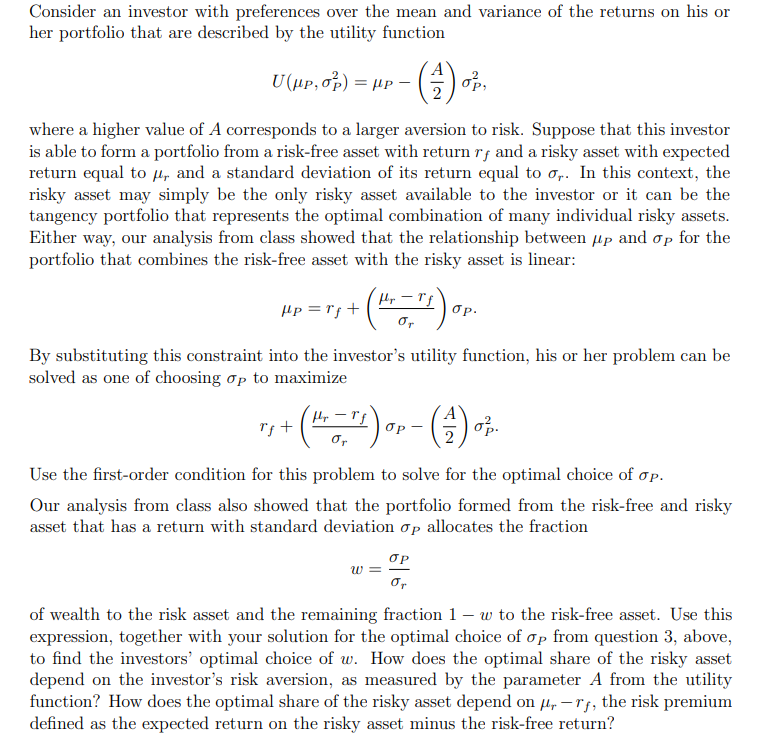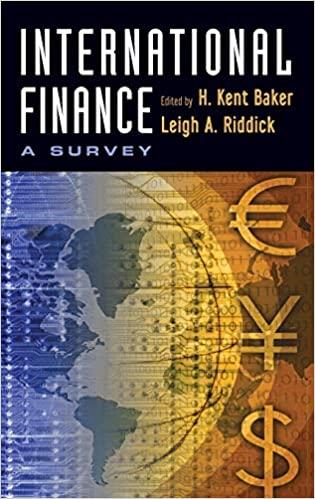
Consider an investor with preferences over the mean and variance of the returns on his or her portfolio that are described by the utility function U(P,P2)=P(2A)P2, where a higher value of A corresponds to a larger aversion to risk. Suppose that this investor is able to form a portfolio from a risk-free asset with return rf and a risky asset with expected return equal to r and a standard deviation of its return equal to r. In this context, the risky asset may simply be the only risky asset available to the investor or it can be the tangency portfolio that represents the optimal combination of many individual risky assets. Either way, our analysis from class showed that the relationship between P and P for the portfolio that combines the risk-free asset with the risky asset is linear: P=rf+(rrrf)P. By substituting this constraint into the investor's utility function, his or her problem can be solved as one of choosing P to maximize rf+(rrrf)P(2A)P2. Use the first-order condition for this problem to solve for the optimal choice of P. Our analysis from class also showed that the portfolio formed from the risk-free and risky asset that has a return with standard deviation P allocates the fraction w=rP of wealth to the risk asset and the remaining fraction 1w to the risk-free asset. Use this expression, together with your solution for the optimal choice of P from question 3, above, to find the investors' optimal choice of w. How does the optimal share of the risky asset depend on the investor's risk aversion, as measured by the parameter A from the utility function? How does the optimal share of the risky asset depend on rrf, the risk premium defined as the expected return on the risky asset minus the risk-free return? Consider an investor with preferences over the mean and variance of the returns on his or her portfolio that are described by the utility function U(P,P2)=P(2A)P2, where a higher value of A corresponds to a larger aversion to risk. Suppose that this investor is able to form a portfolio from a risk-free asset with return rf and a risky asset with expected return equal to r and a standard deviation of its return equal to r. In this context, the risky asset may simply be the only risky asset available to the investor or it can be the tangency portfolio that represents the optimal combination of many individual risky assets. Either way, our analysis from class showed that the relationship between P and P for the portfolio that combines the risk-free asset with the risky asset is linear: P=rf+(rrrf)P. By substituting this constraint into the investor's utility function, his or her problem can be solved as one of choosing P to maximize rf+(rrrf)P(2A)P2. Use the first-order condition for this problem to solve for the optimal choice of P. Our analysis from class also showed that the portfolio formed from the risk-free and risky asset that has a return with standard deviation P allocates the fraction w=rP of wealth to the risk asset and the remaining fraction 1w to the risk-free asset. Use this expression, together with your solution for the optimal choice of P from question 3, above, to find the investors' optimal choice of w. How does the optimal share of the risky asset depend on the investor's risk aversion, as measured by the parameter A from the utility function? How does the optimal share of the risky asset depend on rrf, the risk premium defined as the expected return on the risky asset minus the risk-free return







